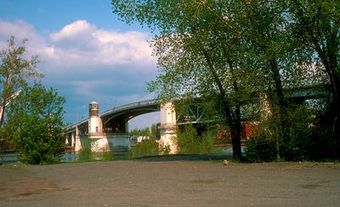Témiscaming, Quebec, incorporated as a town in 1988, population 2,368 (2021 census), 2,431 (2016 census). Témiscaming is located at the southern end of Lac Témiscamingue (spelled Timiskaming in Ontario) near the rapids that link the lake with the Ottawa River. In 1888, a sawmill was built nearby.
Settlement
Témiscaming was established in 1917 by the Riordon Pulp and Paper Company, which bought the sawmill and wanted a town to house the employees of its Kipawa Mills paper mill. Thomas Adams was hired as the planner, and he designed the town in the Garden City style. In 1920, it was incorporated under the name of the mill (Kipawa) but was renamed the following year. The name Témiscaming is derived from an Algonquin expression meaning "deep water," a reference to the lake. Incorporated into Kipawa was the hamlet of South Témiscaming, which was the Canadian Pacific Railway terminal for the area and the steamship port for goods destined for the new communities to the north of Lac Témiscamingue. The railway station built in 1927 is now a historic building.
Development
Témiscaming was for many years a company town. Originally owned by the Riordon Company (1917-25), it was then directly administered by the Canadian International Paper Company (CIP) until the end of the 1960s. CIP had bought the town as well as the Kipawa Mills plant. In 1972, ownership of the mill passed on to Tembec, a company set up by management and workers of the mill after CIP shut the mill down. Témiscaming's economy is still based on its paper mill, which, as of November 2017, is owned by Rayonier Advanced Materials. In 1988, Témiscaming was amalgamated with the municipality of Letang (incorporated in 1980) to form the present town.

 Share on Facebook
Share on Facebook Share on X
Share on X Share by Email
Share by Email Share on Google Classroom
Share on Google Classroom


